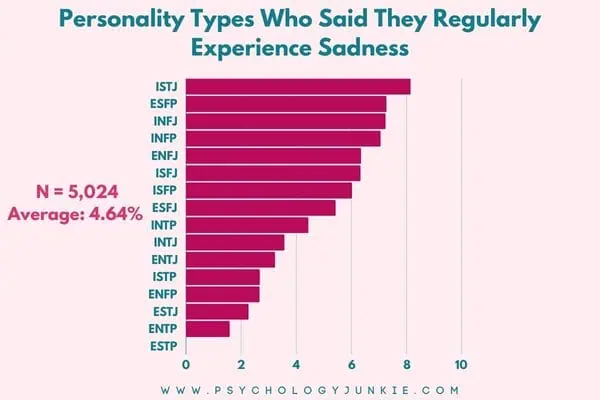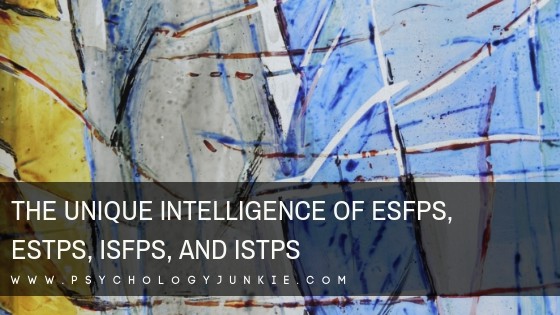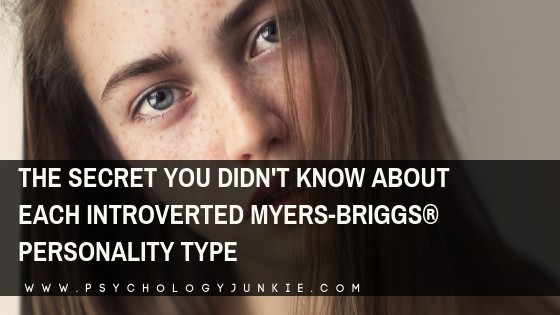Which Myers-Briggs® Personality Types Are Most Prone to Sadness?
Is there any relationship between sadness and your Myers-Briggs® personality type? I recently conducted a survey with over 5,000 respondents. In the survey, one of the questions I asked was, “What emotion do you experience most regularly?” There were 21 options for people to choose from, ranging from “Joy” to “Contentment” to “Pessimism.” Sadness was one of those 21 options, and I urged survey respondents to select only the top 1-3 emotions they experienced most.
Today we’re going to explore the results of that survey, and some of the comments that people who took the survey left as insights into their feelings. Let’s get started!

Not sure what your personality type is? Take our new personality questionnaire here. Or you can take the official MBTI® here.
Which Myers-Briggs® Personality Types Are Most Prone to Sadness?

Estimated reading time: 13 minutes
1. ISTJ – 8.15%
ISTJs are usually the steady, reliable ones. They’re not the types to wear their hearts on their sleeves. Instead, they tend to push their feelings aside while there is work to be done, only unlocking them and lifting them out when they’re fully alone and able to process without fear of judgment or exposure.
My grandfather was an ISTJ. He was always steady and thoughtful. Nothing seemed to rattle him. But he was also the most nostalgic, sentimental, kind person I’ve known. I know that in his more private moments he allowed himself to feel things that he rarely showed to others. But I noticed that when he would get emotional, he’d just get quiet, smile, and keep it contained.
Beneath their calm exterior, ISTJs often are more sensitive than they appear. “I feel like I have to keep it together for everyone else,” one ISTJ told me. Another said, “I wouldn’t say I’m a sad person, per se. But I have to process both the good and the bad, I can’t ignore it.” And another stated, “I’m actually really sensitive. I cry really easily but I don’t want to show it. I can feel deeply moved by an insurance commercial, a kids movie, so many things.”
It’s important for ISTJs to know that repression long-term isn’t the key. Busy ISTJs with packed schedules almost never make time to unpack their feelings; instead, they continually push them aside so they can focus on their responsibilities. When I asked the ISTJs I spoke with what types of activities helped them process their feelings, they suggested writing them down, talking to a therapist, creating art, or exercising while examining them.
Find out more about ISTJs: 10 Signs of an Unhealthy ISTJ
2. ESFP – 7.27%
I was surprised to see ESFPs so highly on the list. On the outside, these types tend to seem fun, spontaneous, and eternally optimistic. But there’s more to these types than what you see on the exterior. Overall, ESFPs ranked highly for feelings of optimism, excitement, and joy, but along with all that brightness was the juxtaposition of sadness.
I’m an optimist,” one ESFP commented, “but when life slows down or I have to do mundane tasks, I feel sad and more anxious than usual.” Several other ESFPs mirrored her statements, commenting that they like to stay as busy as possible, but if life is too mundane, slow, or quiet they can be overcome by sad thoughts. My ESFP friend tends to be plagued by negative thoughts when she tries to sleep at night, when life slows down, quiets down, and is under-stimulating.
As Extraverted Sensing dominants, it’s possible that when all the sensory stimulation shuts down, ESFPs get more in touch with their introverted feeling side. This is the part of them that processes emotions, values, and personally significant experiences. When ESFPs make time to tap into introverted feeling without trying to distract themselves, it can help them to feel less overwhelmed by their emotions. But for some ESFPs, reverting to action and experience is all too tempting. While I’d love to give a list of ways for ESFPs to cope with sadness, I know that it will depend on the ESFP. But the key is to fully examine your feelings instead of trying to distract from them. Write them down, talk to someone, and acknowledge them without giving into the temptation to distract. Calm has written an excellent article on how to process feelings, and why it’s so important that might be helpful here.
3. INFJ – 7.24%
INFJs feel deeply. Not just their own emotions, but everyone else’s too. They’re like emotional sponges, soaking up the moods and feelings of the people around them. As big-picture people, INFJs find themselves dreaming of a better world for people. Idealists by nature, they sympathize with the plight of humanity and want to find ways to improve everything. Yet this desire to change the world and make it better is impossible for one human to accomplish all on their own. Many INFJs report that they feel sadness when they sense that they can’t create the ideal world they’ve envisioned on their own.
I feel sadness, but it doesn’t bother me” one INFJ stated, “I think grief, sadness, solitude are all things we need to realize in order to gain the full spectrum of the human experience.” Other INFJs made similar statements. When sadness sets in, INFJs often need time alone to process. They might turn to journaling, meditating, or losing themselves in a creative project. It’s their way of making sense of the emotional noise around them. Others need an outlet, someone to talk to who can mirror their feelings back to them, but only after they’ve had some time to decompress alone first.
Find out more about INFJs: 3 Weird and Wonderful Secrets About the INFJ
4. INFP – 7.06%
For INFPs, sadness often has a kind of beauty to it. They feel things deeply and are attuned to the nuances of their emotional world. They might feel sadness when they see the gap between their ideals and reality or when they feel misunderstood. I don’t mind feeling sad,” an INFP confided. “It makes me feel like I’m alive.” Another stated, “I don’t buy into the whole toxic positivity mindset. There’s nothing wrong with processing negative emotions. There’s beauty in everything we feel.”
For INFPs, sadness often finds a release through artistic or creative expression or immersion. This can mean listening to music that resonates with their emotions, watching a movie, writing a story, or creating art to express themselves or find solidarity.
Find out more about INFPs: September Bucket List Ideas for INFPs
5. ENFJ – 6.35%
ENFJs are deeply in touch with the emotional world around them. They tend to absorb other people’s emotions, sometimes even confusing them with their own. This ability to be an empath and to care so deeply for others can be both a blessing and a curse. It gives them the knack for creating a positive atmosphere with another person. Yet at other times they become overwhelmed by negative or difficult emotions from others. As Idealists, ENFJs long for a better and kinder world. The fact that so many people suffer is not lost on them, and it’s something they process more intensely than many other types.
“I wouldn’t say I’m a sad person. In general I’m an optimist. But I’ll get depressed and then happy literally in the same day. I just have radically different mood swings” one ENFJ commented. Another said, “I’m a happy person. I just get sad, I guess, when other people around me are sad. I take those feelings on.”
ENFJs might suppress their own sadness to keep supporting others, but when it surfaces, it can be quite intense. They need to be reminded to take care of themselves and to let others be there for them once in a while.
6. ISFJ – 6.33%
ISFJs are all about taking care of the people around them, often putting their own needs on the back burner. Their sadness usually comes from worrying about others or feeling unappreciated. I get sad when I think I’m not doing enough for others,” an ISFJ said. Another stated, “I feel taken for granted and a lot of people don’t notice the things I do. It can be hard to snap out of.”
ISFJs often chose not show their sadness outwardly, instead channeling it into their work or dealing with it privately. But it’s important for ISFJs to find an external outlet for their emotions. Writing down their feelings and reading them back to themselves can be extremely helpful, or finding a trusted friend or family member to confide in.
Find out more about ISFJs: 10 Things You Crave Every Day as an ISFJ Personality Type
7. ISFP – 6.02%
For ISFPs, sadness is often a solo experience. They don’t really like showing all their feelings, but they may find it hard to hold back if they have no way to get alone. They tend to feel sad when they feel like they can’t express themselves, like they’re being misunderstood, or someone they care about is hurting. It’s hard to explain, but it’s like a wave that comes over me,” one ISFP shared. They’re not always comfortable talking about their sadness, preferring to process it through art, nature, or solitude. Many ISFPs convey a more private, stoic outward appearance while on the inside they are deeply sensitive and emotionally intelligent.
Find out more about ISFPs: 10 Things ISFPs Need in a Relationship
8. ESFJ – 5.43%
ESFJs are tuned into the emotional states of others and often feel responsible for the overall mood. “I just want everyone to get along,” one ESFJ told me. If they feel disconnected or like they’ve disappointed someone, it can bring them down and make them feel restless and agitated until everything is resolved.
I notice ESFJs getting the most upset when they feel their relationships are in jeopardy. They usually cope by seeking out their loved ones, talking things through, and having sounding boards for their emotions. Having someone to listen, affirm, give advice, or offer emotional support is key.
Find out more about ESFJs: Understanding ESFJ Rage
9. INTP – 4.44%
INTPs tend to keep their emotions at a distance, preferring the world of logic, where everything makes sense, instead. But sadness can creep in when they feel rejected, misunderstood, or frustrated with themselves. I don’t always understand why I’m sad,” an INTP confessed, “and the last thing I need is someone badgering me to find out why I seem sad. That just makes it worse.”
They tend to withdraw and analyze their feelings, looking for a logical reason behind their emotions. Sometimes this is an exercise in futility. Several INTPs commented that they just need to blow off steam when they’re sad without worrying about how they’ll be interpreted, because they often make sense of their emotions this way and can re-calibrate. They find comfort in solitary activities, reading, or diving into a new area of interest to distract themselves and find a sense of balance.
Discover more about INTPs: The Top 3 Best Matches for the INTP Personality Type
10. INTJ – 3.57%
For INTJs, sadness can feel like a disruption to their inner order. Sadness feels like something I need to fix,” an INTJ said. They’re more likely to internalize their feelings, analyzing the situation to prevent future setbacks. Or they might retreat into their feelings privately, listening to songs that match their moods, writing in journals, or looking for an insight or deeper meaning.
I personally am an INTJ and I would say sadness is one of my strongest and most frequent emotions. Do other people see it? Not so much. I tend to write out my feelings, listen to music that gives me a sense of solidarity, or contemplate the sadness in my own way. If I do show my feelings, it’s unintentionally and usually something I detest. I am only one INTJ, though. So I’d love to hear from others in the comments. From what I’m seeing from other INTJ survey respondents, it’s fairly typical to keep feelings hidden, dealing with them in private rather than needing sounding boards in other people.
Find out more about INTJs: The INTJ Woman: Joys and Challenges
11. ENTJ – 3.23%
ENTJs are action-oriented and often suppress emotions that don’t seem productive. When sadness does hit, it’s usually tied to a perceived failure or a setback in their plans. It’s more of an annoyance than anything,” one ENTJ shared. They’re quick to move into problem-solving mode, focusing on what they can do to change the situation. They might view sadness as something to overcome rather than a feeling to explore.
12. ISTP – 2.68%
ISTPs are practical and prefer to stay focused on the present. Sadness usually comes when they feel stuck or misunderstood. While ISTPs are logical and have a certain detached, analytical quality, this doesn’t mean they are heartless. Everyone thinks I have no feelings,” said one ISTP, “but they don’t know I literally cry in any movie where an animal dies. I’m a huge softie when it comes to animals or kids.” They often deal with sadness by engaging in physical activities, like working out or diving into a hands-on project. They’re not ones to talk about their emotions unless they see a need to, and if they do talk, they want it to be with someone who won’t criticize their emotions. They may backtrack later after they’ve externalized their emotions, discarding anything that doesn’t seem “logical enough.”
13. ENFP – 2.67%
ENFPs are known for their upbeat and enthusiastic nature, but they can experience sadness when they feel disconnected from their values or sense of purpose. I get sad when things feel meaningless,” one ENFP admitted. They usually try to reframe their sadness, viewing it as a part of a larger growth journey. They might explore their feelings through creativity, conversations, or by seeking out new experiences to reignite their sense of joy.
14. ENTP – 1.59%
ENTPs are usually too busy exploring new ideas to sit with sadness for long. I feel sad when my relationships are failing in some way,” one ENTP commented, “It makes me feel incompetent. And I hate it because I just blurt out all my feelings and then people take them way too seriously. I just gotta get it out of my system, then I can breathe, say ‘that was stupid’ and get back to life as normal.” Several other ENTPs mentioned this same pattern. Because ENTPs don’t have Introverted Feeling in their primary cognitive function stack it can be difficult for them to internalize and inwardly process their emotions. Often they need to just blurt them out to organize and make sense of things. Throughout that process they may take back certain things they said as they calibrate, and it’s important for them to have someone as a sounding board who isn’t hounding them about every little or thing or getting hypersensitive to their process.
15. ESTJ – 2.27%
ESTJs are typically practical and focused on getting things done. They see sadness as something that could get in the way of their goals. I don’t have time to be sad,” one ESTJ said. When they do feel it, it’s often linked to perceived failures or inefficiencies. They prefer to channel their feelings into action, finding ways to solve problems and keep moving forward.
16. ESTP – 0.00%
ESTPs are the least likely to report feeling sadness regularly. They’re all about living in the moment and seeking excitement. I just keep moving,” an ESTP said. When they do feel sad, it’s usually short-lived and specific to an event. They often cope by diving into activities that provide a quick mood boost, like sports, exercise, socializing, or anything that keeps them on their toes.
What Do You Think?
How do you cope with sadness? Do you have any tips, stories, or advice to share with others? Let us know in the comments!

Subscribe to Our Newsletter

Want to discover more about personality type? Get the inside scoop with Susan Storm on all things typological, along with special subscriber freebies, and discounts on new eBooks and courses! Join our newsletter today!











I am an INTJ. I feel sad occasionally but rarely show it. I don’t have any close friends to be able to talk to, so I close those feelings off and try not to think about it.